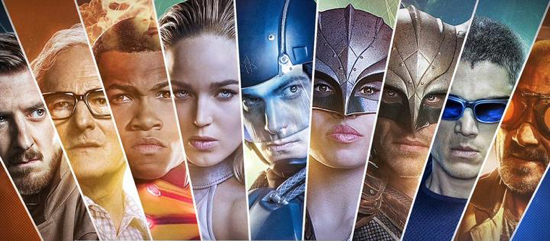Marc Alan Fishman: Legends(ish) of Tomorrow(sorta)
DC’s Legends of Tomorrow, upon being announced, caught me dumbfounded. Hot on the heels of The Flash, which spun out from Arrow, this new time-hopping romp through the unknown left me in between diametric emotional states. The first was joyful confusion. Where all current DCU-TV joints were clearly single-hero driven vehicles (The Flash, Arrow, Supergirl… and Gotham, sorta), here was something decidedly team-based… and a large team to boot.
This lead straight to the antithetical emotion: crippling fear. With nine “leads” – all of whom were D-Listers or complete canonical lies – and a show built around time periods only the most pernicious perusers of prose would recognize, I was afraid it was all too much too soon.
I was both right and wrong about it. Natch.
When I last talked about the show there were far too many variables being hammered into submission to draw final conclusions. But I was certainly a snarky so-and-so over the very odd choices the writers applied to the character of Firestorm. But as is often the case, TV shows are malleable in their freshest forms.
Over time, the chemistry of the cast coagulates. The writers create serialization. Layers build on top of layers and, soon enough, you have a sandbox where creatives create and the audience visits every so often. Some shows feel well-worn from the get go (The West Wing). Others take a season or more to find their footing (Parks and Recreation, Agents of SHIELD…). I’m happy to report that Legends found its footing for me somewhere around mid-season.
The show pushed itself harder into characterization. Rather than be forced to drag on and on with psuedo-science and timeline refraction and Rao-knows-what, Legends adopted a quicker pace that refocused the show on just being a silly romp. We were transported to the wild west for a team-up with Jonah Hex. The following week, we went to the 1950s for a horror-twinged episode about the night of the living Hawkmen. And then, off to the far flung future to learn that (SPOILER ALERT) Heatwave was Chronos all along. You might even postulate though all of this that the show started to feel more like a comic book. And with it came the good vibes I was hoping all along.
The strongest points have been specifically with the ne’er-do-well duo of Mick and Leonard – Heatwave and Captain Cold. Tossed in at the get go as the villains with the hearts of gold, Dominic Purcell and Wentworth Miller stole every scene they were in. Whether it was quick comebacks, threats of imminent violence or casual admittance to love of baked goods, there simply wasn’t a time they didn’t command attention. With the fleshing out of the season, Mick’s Chronos gained pathos as the friend with the knife in his back. And Leonard got his moment to shine in self-sacrifice to boot.
Beyond the malcontents on the ship, the B-Listers Firestorm and the Atom did well to recede from the limelight. We were given glimpses into their less-than-complicated backstories to at least flesh things out. By season’s end, Firestorm – complete with BFFs Martin Stein and Jefferson Jackson – was transmuting matter and truly working as a single unit. Pepper this in with Jax being able to bust ‘Grey’s’ chops over being a college stoner and you got the witty repartee indicative of an 8 PM drama on the CW. Meanwhile Brandon “Not Fit for the Big Blue Boy Scout” Routh found firmer footing in the forever-awkward Dr. Ray Palmer. Shackled with a romance-plot-that-was-doomed-from-the-get-go, the eternally optimistic Atom granted the necessary silver lining when the plots dragged things down into the doldrums.
From there we reach the lower points of the season and show. For whatever the reasons are, I personally never cared much for our White Canary. I’ve not seen Arrow before, so, the character is a blank slate to me. And given that the entirety of her season arc was to just be the badass girl who is a badass, she was basically on the show to act as a not male member of the team. Ce la vie.
Our other female lead on the show – Kenda “Hawkgirl” Saunders – was just an absolute mess to manage. As one of the strands fraying from the edge of The Flash, the reincarnated Egyptian princess doomed to be killed in every life by the immortal Vandal Savage was played as a vapid plot device for the entirety of the season. One episode, she was a fighting machine laying waste to all sorts of enemies. The next, a depressed waif leading a false life with the Atom as her husband. The next finally granted some clarity in her character, and immediately kidnapped for the final few shows. As strong as she was played – with no backstory – in Justice League (the cartoon), here in real life, the character was truly one-dimensional. Oh, and Hawkman was there for a few episodes too. Meh.
All these paths lead to Rip. The Time Master himself, played by former Doctor Who companion Arthur Darvill, played not dissimilarly from his BBC counterpart. Forever an enigma, always willing to fight the right fight, but always with an air of odd aloofness. As the season lingered, we were given more pieces to the Rip Hunter puzzle. An orphan with a rambunctious side, a Padawan who tripped into real love, and finally a forlorn father clinging on to hope.
While I largely found Rip himself to always be a slave to the plot more than a three-dimensional character, the final episodes better cemented the character moving forward. He is a rebel with a cause. To undo the snobbish and authoritarian ways of the former Time Masters, Rip Hunter will ride the Waverider to save the timeline from any lingering damage that lurks in the odd pockets.
And frankly, time won’t move fast enough for the second season to get here. Tally ho, Legends!












